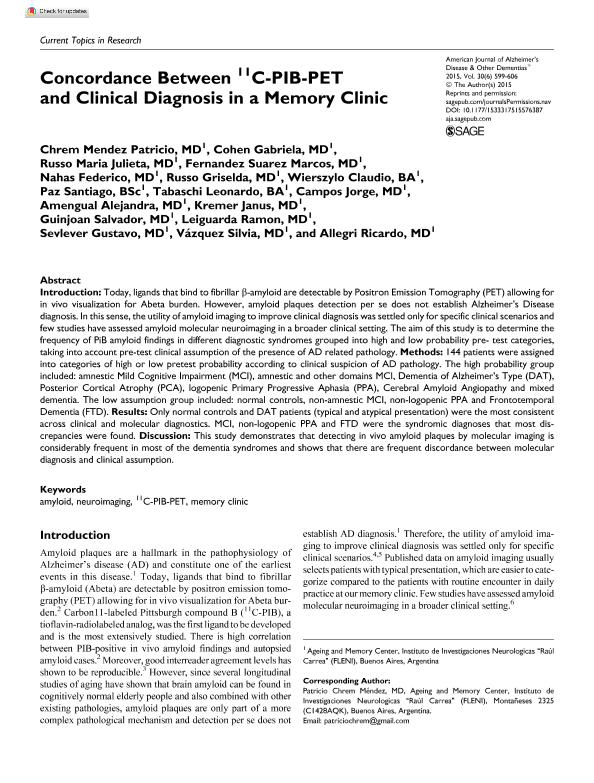Artículo
Concordance between 11C-PIB-PET and clinical diagnosis in a memory clinic
Chrem Mendez, Patricio Alexis; Cohen, Gabriela; Russo, María Julieta; Fernandez Suarez, Marcos; Nahas, Federico Exequiel ; Russo, Griselda; Wierszylo, Claudio; Paz, Santiago Rodrigo; Tabaschi, Leonardo; Campos, Jorge; Amengual, Alejandra; Kremer, Janus; Guinjoan, Salvador Martín
; Russo, Griselda; Wierszylo, Claudio; Paz, Santiago Rodrigo; Tabaschi, Leonardo; Campos, Jorge; Amengual, Alejandra; Kremer, Janus; Guinjoan, Salvador Martín ; Leiguarda, Ramón Carlos; Sevlever, Gustavo; Vazquez, Silvia Ester; Allegri, Ricardo Francisco
; Leiguarda, Ramón Carlos; Sevlever, Gustavo; Vazquez, Silvia Ester; Allegri, Ricardo Francisco
 ; Russo, Griselda; Wierszylo, Claudio; Paz, Santiago Rodrigo; Tabaschi, Leonardo; Campos, Jorge; Amengual, Alejandra; Kremer, Janus; Guinjoan, Salvador Martín
; Russo, Griselda; Wierszylo, Claudio; Paz, Santiago Rodrigo; Tabaschi, Leonardo; Campos, Jorge; Amengual, Alejandra; Kremer, Janus; Guinjoan, Salvador Martín ; Leiguarda, Ramón Carlos; Sevlever, Gustavo; Vazquez, Silvia Ester; Allegri, Ricardo Francisco
; Leiguarda, Ramón Carlos; Sevlever, Gustavo; Vazquez, Silvia Ester; Allegri, Ricardo Francisco
Fecha de publicación:
09/2015
Editorial:
SAGE Publications
Revista:
American Journal of Alzheimers Disease and Other Dementias
ISSN:
1533-3175
Idioma:
Inglés
Tipo de recurso:
Artículo publicado
Clasificación temática:
Resumen
Introduction: Today, ligands that bind to fibrillar β-amyloid are detectable by Positron Emission Tomography (PET) allowing for in vivo visualization for Abeta burden. However, amyloid plaques detection per se does not establish Alzheimer's Disease diagnosis. In this sense, the utility of amyloid imaging to improve clinical diagnosis was settled only for specific clinical scenarios and few studies have assessed amyloid molecular neuroimaging in a broader clinical setting. The aim of this study is to determine the frequency of PiB amyloid findings in different diagnostic syndromes grouped into high and low probability pre- test categories, taking into account pre-test clinical assumption of the presence of AD related pathology. Methods: 144 patients were assigned into categories of high or low pretest probability according to clinical suspicion of AD pathology. The high probability group included: amnestic Mild Cognitive Impairment (MCI), amnestic and other domains MCI, Dementia of Alzheimer's Type (DAT), Posterior Cortical Atrophy (PCA), logopenic Primary Progressive Aphasia (PPA), Cerebral Amyloid Angiopathy and mixed dementia. The low assumption group included: normal controls, non-amnestic MCI, non-logopenic PPA and Frontotemporal Dementia (FTD). Results: Only normal controls and DAT patients (typical and atypical presentation) were the most consistent across clinical and molecular diagnostics. MCI, non-logopenic PPA and FTD were the syndromic diagnoses that most discrepancies were found. Discussion: This study demonstrates that detecting in vivo amyloid plaques by molecular imaging is considerably frequent in most of the dementia syndromes and shows that there are frequent discordance between molecular diagnosis and clinical assumption.
Palabras clave:
11c-Pib-Pet
,
Amyloid
,
Memory Clinic
,
Neuroimaging
Archivos asociados
Licencia
Identificadores
Colecciones
Articulos(SEDE CENTRAL)
Articulos de SEDE CENTRAL
Articulos de SEDE CENTRAL
Citación
Chrem Mendez, Patricio Alexis; Cohen, Gabriela; Russo, María Julieta; Fernandez Suarez, Marcos; Nahas, Federico Exequiel; et al.; Concordance between 11C-PIB-PET and clinical diagnosis in a memory clinic; SAGE Publications; American Journal of Alzheimers Disease and Other Dementias; 30; 6; 9-2015; 599-606
Compartir
Altmétricas



